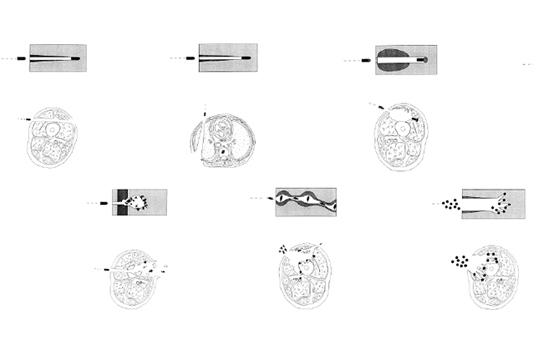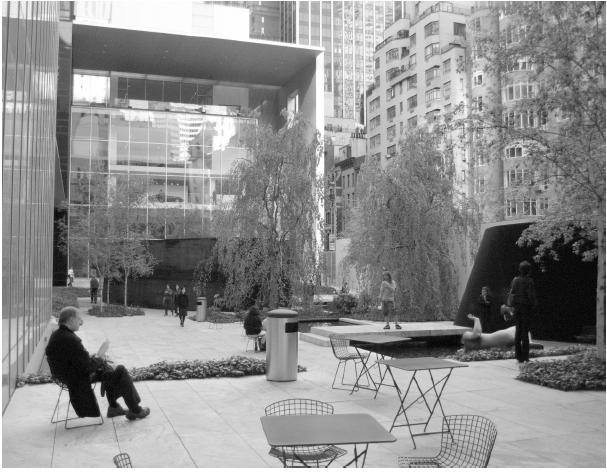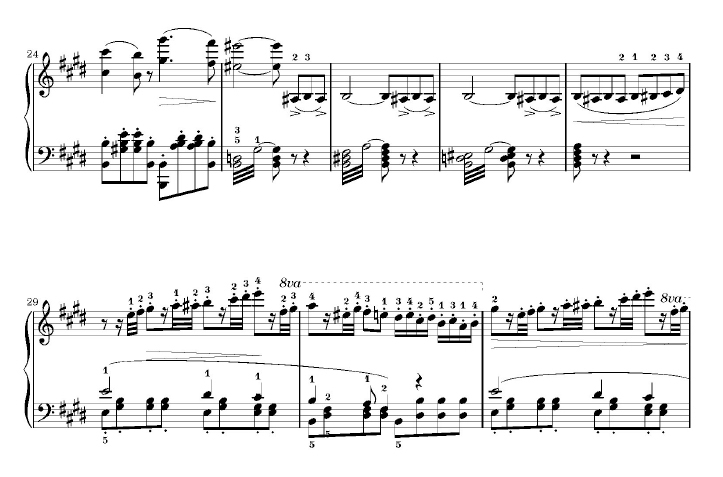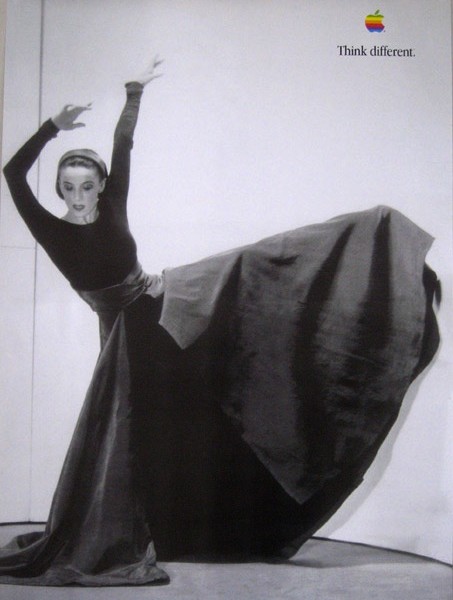I AM 1984 is the first part of the trilogy with the working-title :
Theory of a performance to come or the only way to avoid the massacre is to become its authors?
Self-Interview
-This text was the base of the piece that became I AM 1984.
-GC & BM are acronyms, slogans, acts.
GC Good evening. Actually, I meant to open with another question, but while talking to you just now about the function of the title… [microphone stops working, GC taps on it several times with his finger] ah there it is… [microphone is back] I was saying : Good evening. Actually, I meant to open with another question, but while talking to you just now about the function of the title, and I know what an important role it has in your work – I would first like you to explain how you came up with the idea of this trilogy: “Theory of a performance to come or the only way to avoid the massacre is to become its authors?”
BM Good evening. I will try.
GC Could we say right away that it is a quotation ?
BM Yes, I took over some elements of the first manifesto by the Japanese group Gutai,… we’re talking about the beginning of the Fifties.
GC What you mean to say is that other artists have already dealt with the same subject? For instance, Laurie Anderson who was saying, during the Eighties, that “terrorists are the only true artists”?
BM [looks down at her shoes for few moments before answering] Mmm…, yes, she went so far as to buy As Shahab, the Al-Quaida’s video-production company. If you think about it, Stockhausen and Damien Hirst have recently commented on this issue, referring to the attack of 9/11, but my story has somewhat different origins. My point of departure was the homework essay by Eric Harris, student of The Columbine High School who, together with Dylan Klebold, attacked their school killing 15 persons and wounding as much on the 20 April 1999. In this essay, for which he got a high grade, 69 out of 75 points, he wrote things such as: [reads from the screen of her Apple PowerBook G4, white]”students can’t learn well in school if they know that somebody is pointing a gun at them” or ” I am a firearm, a semi-automatic Wildey 45″.
In an other essay, Dylan Klebold describes the future massacre in detail, up to the trajectory of the bullets entering through the sculls, like a real ballistic expert.
[Shows the photos on the big screen in the back of the stage.]

His teacher, slightly upset after having read the essay, tells him: « I would like to have a word with you before giving you a grade. You have a real talent for telling stories, but I have a problem with this one ». [Long silence.] He wasn’t telling a story !
GC What you mean to say is that the text you’re saying in I AM 1984 is a story of a massacre?
BM Well, not really. I mentioned the group Gutai a minute ago. Recently, a 25-year-old guy spread panic on the streets of Tokyo. First he rushed his truck into the crowd, then he went out of the vehicle and started to beat the passers-by randomly, screaming: « I came to kill » [one spectator laughs]. Or this Japanese artist, Saburo Murakami and his performance called Breaking through many paper screens. He did this performance in the Fifties for the first time and he repeated it recently in the Centre Georges Pompidou in Paris – he ran through 17 papers set a meter apart from one another. I’m still thinking in terms of quotation…
GC The city as an « art gallery », and, – using the same logic – massacre as art; a bretonian vision of the simplest surrealist act – to go out on the streets, a gun in hand, and shoot randomly in the crowd, as long as you can…
BM One should keep in mind that Eric Harris got a high grade for his essay : 69/75. If we continue by the same logic, we could set a value, i.e. a price of some other act, for example the attack on the Twin Towers. We could call it 11/9 Inc. and we could watch its value raise and fall on the art market. Considering the current financial crisis, I’m sure it would be the only one not to lose any points. Someone is undoubtedly doing it already; I’m not saying anything new.
GC This makes me think of the Russian multi-millionaire Roman Abramovitch, whose wealth is of a somewhat dodgy origin, and who is financing The Garage, a huge exhibition space which opened recently in Moscow and which is run by his new girlfriend.
BM It’s not by chance that you think of Abramovitch, in fact he is the owner of the British football team Chelsea, which is the first sports organization to be listed on the Stock Market. But, you being an Italian, I’m sure you’re familiar with such things…
GC I’ll tell you a story that illustrates well what we’re talking about. Silvio Berlusconi, who also owns a football team in Milan, recently called a live teleshopping program and said: Hello, my name is Silvio Berlusconi and I would like to buy your set of knives.”
BM [laughs]
GC What do you think he will do with those knives?
BM I don’t know, maybe he wants to take the Italian Parliament into hostage!
GC [laughs]
BM It’s just like that Macedonian journalist who described in the Utrinski vesnik three cases of homicide up to the smallest detail. In the end, it turned out that he was the murderer, because he revealed more details than even the police knew. Moreover, he wrote about the trials to the persons indicted for the murders.
GC I don’t see the connection, but let’s go back to what you were saying about quotations…
BM [presses a key on her computer, a photo of some garden appears on the big screen, she stands up, talks animatedly, makes gestures with her arms, walks right and left, looking at her shoes]

What I want to say is that when, for example, Jean Tinguely realizes his Hommage à New York in 1963 in the garden of MOMA and makes it auto-destruct in 27 minutes, then it is a quote of the 27 minutes that took for the Twin Towers to collapse, while the whole world stood watching. Are the terrorists quoting Jean Tinguely ? Or are they making a «critique of architecture », so dear to Debord? Maybe in hundred years they will belong to art history!
[she suddenly stops, raises her eyes, seems to be contemplating a distant landscape. Brief silence].
GC But in the aftermath, they didn’t demand that the attack be interpreted as a quote.
BM [rushing back to her seat] But we will do that for them! We are already doing it, we have already done it!
In the Eighties in England, Bob Acraman proposed vacations in the reconstructions of Nazi concentration camps, under surveillance of armed men in uniforms, with the supplement of 25 dollars for a nerve-trying cross-examination. Wouldn’t you call that a situation?
GC Then why not thinking that Walt Disney’s amusement parks quote situationists’ theories of dérive – the drift, giving opportunity for swift changes in environment, affirming the playfulness of one’s behavior. These kinds of parallels are completely wrong!
[raises his arms, as if holding a big sphere suspended above his head, stays immobile for a second, then lets it drop on his head.]
BM If you have the Fifties in mind, then you’re right. But today, the Disney parks are real cities, a specific model of urbanism. Cities with a script. Debord said: “Some day, we will build cities so that we can practice the drift.” In those days, he suggested that aerial shots of cities be used for this purpose, but today we have Google maps. Back then, he constructed a city out of cardboard on a scale of 1 : 1 000 000 for a social game he invented, called “The War Game”. Today the field of the game is the city itself, and the game is called PacManhattan. We no longer move the plastic pawns on an imaginary surface because today we are the ones who are moving on the chessboard of the city, accomplishing different tasks, with the help of GPRS…and the overture of Verdi’s Traviata. [Traviata starts playing in the background]

GC What a strange concept! [the music becomes increasingly loud, too loud.] Can’t you turn down the volume?
BM [yelling] It’s not a concept, it’s an allegory! Allegory is also a concept, but has vitamin C added to it! [music stops.]
GC So, who is amused by this new game on a 1:1 scale?
BM You mean, who is listening to Verdi’s overture? Well, it’s not the person who is moving through the city and who is the personification of Pac-Man – he or she is only receiving the instructions through the headphones. The person who is listening to Verdi, in the surround system, is the one who is giving the instructions and who is monitoring Pac-Man’s moves. But, the one who is getting the most kicks out of the Game is the one who is watching it from a distance, and maybe on this third level the music changes, or it comes from some other, hardly identifiable source…
GC [pours water in his glass]
BM [coughs several times] Excuse me…
GC [gives her the glass of water]
BM Thank you. [drinks]
GC Where were we ?
BM [explains with gestures that she doesn’t know either, that she wants to leave, go shopping, buy a mascara.]
GC Oh yes, the city.
BM Los Angeles.
GC That’s the starting point for the first part?
BM Berlin and New York for the second and the third.
GC Why cities ?
BM For the reason we’ve just talked about, for the idea of Totality that they carry in them. For the paradigm of light and guilt, as it used to say… Is it clear?
GC No, but I understand. Let’s go back to I AM 1984, how did the idea for this piece come about ?
BM It came about as a result of the purchase of this computer [she is pointing at her Apple PowerBook G4 white, bought in U.S.A. with her friend Nela.]. It all started with the poster that was hanging on the wall of the shop where I bought it. The poster is one in the series for the Think Different campaign, and to my great surprise it was showing Martha Graham, a modern dance pioneer, in a long black skirt and balancing on one leg. In the upper right corner – an apple in the colors of the rainbow, as a counter-weight to Martha’s precarious position. One might say that the piece is all about this balance.
[ shows the photograph on the big screen.]

GC We should remind the audience that your débuts are closely related to dance.
BM Actually, to television…
GC What do you mean ?
BM I started to dance through the experience of watching TV. Yes… Every year around Christmas, the Croatian TV used to show The red shoes, a film by Powell and Pressburger. I don’t know if you are familiar with the plot…
GC It’s a tale by H.C. Anderson.
BM Yes, it’s about a girl who buys a pair of red shoes, goes out dancing, but when she wants to stop and go home because she’s tired, she realizes that the shoes had been bewitched, and that she can neither take them off, nor stop dancing. In the end, she dies of exhaustion.
GC What shoes are you wearing this evening, we wouldn’t like to lose you…
BM [both look at BM’s shoes] Black boots.
GC « People go to theatre hoping that they will see actors die on stage » says Jérôme Bel.
BM I’m not sure I understand what he meant by this, maybe he is quoting Agatha Christie, in which case this statement is interesting.
GC What is your relationship with dance today ?
BM « Artist offers escort for contemporary dance shows. »
GC [laughs] And are there any responses?
BM Oh yes, I was contacted by people from all sorts of professions – [suddenly a door opens and a crowd of people comes on stage, almost completely covering GC and BM], by dance lovers or by individuals who were simply curious. I usually propose to them to have a drink after the show, to discuss and exchange opinions. There were some truly interesting meetings so far. For example, this ex-piano teacher [one man raises his hand] who now works as a night-guard in the Ministry of Culture, and who adores dance, especially Cunningham, and who told me about the endless nights he spends watching the entrance and the empty hallways of the Ministry on the monitors. I had the idea to dance the excerpts from Cunningham’s piece Beachbirds for camera in front of the entrance of the Ministry for him. He was delighted by the idea, and we made arrangements to do it that very night… You can see it on YouTubeu, look for Beachbirds under surveillance.
[The crowd leaves the stage. BM and GC are visible again, but something intangible in their appearance has changed. They seem at the same time younger and more tired.]
GC Unfortunately, our time is up, I would just like to ask you the two questions that I ask all of my guests: what do you like to read the most?
BM Official documents and job adverts, I like their pathos. Recently, on the occasion of the European Day Against Violence, the Scelles Foundation organized a symbolic gathering in the Forum des Halles in Paris. Here’s their newspaper advert [reads from her computer’s screen] : ” We are looking for 50 volunteers for the purpose of staging a physical and moral chain of victims behind a window-shop. A petition will be circulating in order to raise the public’s awareness on this issue. Beside acquiring a professional theatrical experience, the participants will contribute to a good cause and support the international mission of solidarity for one afternoon.”
GC Who are your teachers?
BM Charlie Chaplin and probability theory.
GC Do you have any questions for the spectators?
BM No.
GC Thank you BM.
BM Thank you.
They both leave the stage. Dark. Long silence. The computer left on the table activates the RSS screensaver. The following titles come and go:
…Long Night of Museums : murder in the metro …Palin : Obama friend of terrorists … Lehman’s fall precipitated by JP Morgan … Ecstasy to treat the war traumas … First economic consequences due to decline of bees …Jet-man plans to fly over the Channel …last refreshed at 19h18 …
